
What does it mean to be truly authentic in your destination marketing and why is it so crucial? Let’s delve into the heart of this concept and explore practical ways to ensure your destination’s brand remains genuine and engaging.
In the ever-evolving landscape of destination marketing, one concept consistently emerges as the cornerstone of successful branding: authenticity. As I often emphasize on the Destination Marketing Podcast, authenticity isn't just a buzzword—it's the bedrock upon which the most compelling and effective destination brands are built. But what does it mean to be truly authentic in your destination marketing, and why is it so crucial? Let’s delve into the heart of this concept and explore practical ways to ensure your destination’s brand remains genuine and engaging.
The Importance of Authenticity
Authenticity in destination branding means staying true to the core essence of what makes your destination unique. It’s about presenting an honest and consistent image that aligns with the actual experiences visitors will have. When we talk about authenticity, we’re talking about the unembellished truth of your destination—the sights, sounds, culture, and community that define it.
Authenticity is critical for several reasons. Firstly, it builds trust. When potential visitors feel that a destination is genuinely represented, they are more likely to trust the marketing messages they receive. This trust translates into increased bookings and positive word-of-mouth referrals. Secondly, authenticity differentiates your destination from others. In a world where many destinations may offer similar attractions or experiences, being authentic helps to highlight what makes your destination distinct.
Case Study: Nebraska's "It's Not For Everyone" Campaign
One of the best examples of authenticity in action is Nebraska's "It's Not For Everyone" campaign. When John Ricks, Executive Director of Visit Nebraska, evaluated the state’s brand, he realized there was a lot of work to do. Instead of trying to rebrand Nebraska as something it wasn’t, they leaned into the very perceptions that people had. They embraced the flat landscapes and wide-open spaces, turning perceived weaknesses into strengths. This campaign highlighted unique Nebraska experiences like tanking down slow-moving rivers, an activity that is quintessentially Nebraskan and not found anywhere else.
Case Study: Laredo’s Rebrand - Celebrating Culture and History

When Laredo, Texas prepared for a rebrand in 2019, it was clear that authenticity needed to be at the forefront. Laredo is a border town rich in Mexican and Hispanic culture, a vibrant blend that sets it apart from the more stereotypical “cowboy Texas” image that many people associate with the state. The previous branding did not reflect this unique cultural fusion, instead leaning towards a generic Texan identity that didn’t do justice to Laredo’s true spirit.
Their new branding truly represented and celebrated this bi-cultural identity. For instance, the use of the aloe plant in the logo and overall branding symbolized healing and unity, reflecting the close-knit relationship between the communities on both sides of the border. This choice of symbol also aimed to project a message of resilience and togetherness, which is a vital part of Laredo’s identity.
Additionally, the rebrand worked on shifting perceptions by highlighting Laredo’s safety and community spirit. Despite common misconceptions, Laredo is one of the safest cities in the country per capita, and this needed to be communicated effectively. By sharing stories of local experiences and focusing on the positive aspects of life in Laredo, this new strategy changed the narrative and attracted visitors who appreciate the authentic cultural experiences Laredo offers.
Practical Steps to Ensure Authenticity
- Understand Your Core Identity: Before you can market your destination authentically, you need a deep understanding of what makes it unique. This involves thorough research and often requires honest conversations with locals, visitors and stakeholders. What do they love about your destination? What stories do they tell? This feedback forms the foundation of your brand’s core identity.
- Align Marketing Messages with Real Experiences: Ensure that your marketing materials reflect the actual experiences visitors will have. There’s nothing worse for your destination’s reputation than for visitors to arrive and feel misled by your advertising. Authentic marketing means showcasing genuine experiences, even if they aren't the most glamorous.
- Leverage Local Stories and Voices: One of the most powerful ways to convey authenticity is through storytelling. Highlight the stories of locals, their traditions and their lifestyles. This not only adds a personal touch but also provides a richer, more immersive view of what visitors can expect.
- Consistency Across All Touchpoints: Authenticity also means being consistent in your messaging across all platforms and touchpoints. Your website, branded content, paid advertisements and even customer service interactions should all convey the same authentic story of your destination.
- Involve the Community: Your local community is your best (and most authentic) ambassador. Engage them in your branding efforts, whether through social media campaigns, local events or visitor interaction programs. Their genuine passion for the destination can be a compelling part of your brand narrative.
Avoiding Common Pitfalls
While striving for authenticity, it’s important to avoid common pitfalls that can undermine your efforts. Over-promising and under-delivering is a sure way to lose trust. Ensure that your promotional materials are realistic and manage visitor expectations effectively. Additionally, avoid generic marketing messages that could apply to any destination. Instead, focus on what is truly unique about your location.
In the competitive field of destination marketing, authenticity is not just a strategy—it’s a necessity. By staying true to what makes your destination special, you build trust, foster engagement and create lasting impressions that draw visitors back time and time again. Embrace the unique stories, cultures and experiences that define your destination, and let them shine through in every aspect of your marketing. Remember, authenticity isn’t just about being real; it’s about being the best version of what you already are.
By embedding authenticity into your destination’s brand, you not only attract more visitors but also ensure they leave with genuine and memorable experiences, making them ambassadors for your destination long after their visit ends.
Submit Your Thought Leadership

Share your thought leadership with the Destinations International team! Learn how to submit a case study, blog or other piece of content to DI.


